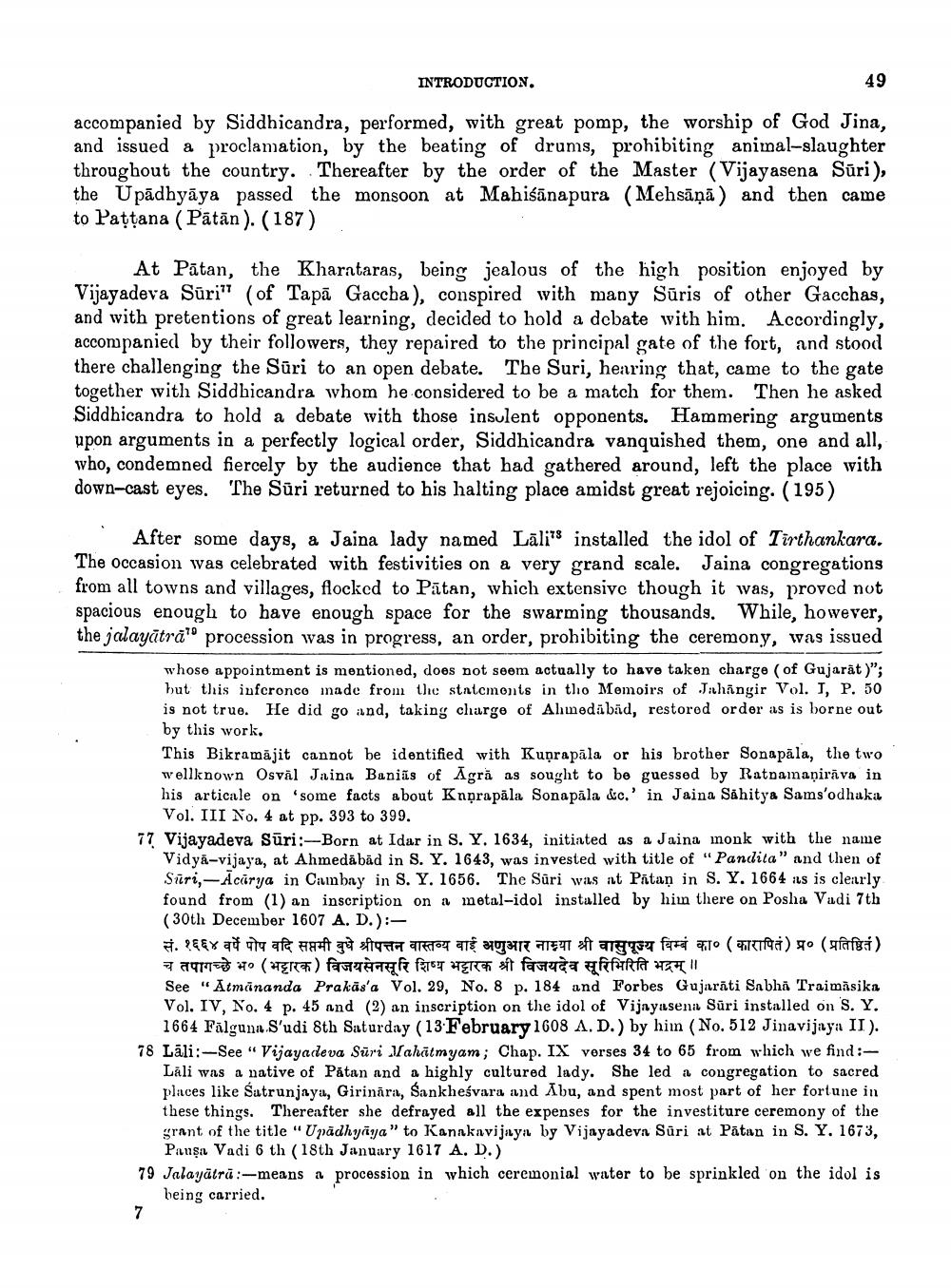________________
INTRODUCTION.
49
accompanied by Siddhicandra, performed, with great pomp, the worship of God Jina, and issued a proclamation, by the beating of drums, prohibiting animal-slaughter throughout the country. Thereafter by the order of the Master (Vijayasena Sūri), the Upādhyāya passed the monsoon at Mahiśānapura (Mehsāņā) and then came to Pattana (Patan). (187)
At Pātan, the Kharataras, being jealous of the high position enjoyed by Vijayadeva Sūri" (of Tapā Gaccha), conspired with many Sūris of other Gacchas, and with pretentions of great learning, decided to hold a debate with him. Accordingly, accompanied by their followers, they repaired to the principal gate of the fort, and stood there challenging the Sūri to an open debate. The Suri, hearing that, came to the gate together with Siddhicandra whom he considered to be a match for them. Then he asked Siddhicandra to hold a debate with those insulent opponents. Hammering arguments upon arguments in a perfectly logical order, Siddhicandra vanquished them, one and all, who, condemned fiercely by the audience that had gathered around, left the place with down-cast eyes. The Sūri returned to his halting place amidst great rejoicing. (195)
After some days, a Jaina lady named Lāli's installed the idol of Tirthankara. The Occasion was celebrated with festivities on a very grand scale. Jaina congregations from all towns and villages, flocked to Pātan, which extensive though it was, proved not spacious enough to have enough space for the swarming thousands. While, however, the jalayātrā procession was in progress, an order, prohibiting the ceremony, was issued
whose appointment is mentioned, does not seem actually to have taken charge of Gujarāt)"; but this infcronco made from the statemonts in thio Momoirs of Jahangir Vol. I, P. 50 is not true. He did go and, taking charge of Ahmedabad, restored order as is borne out by this work, This Bikramăjit cannot be identified with Kuņrapāla or his brother Sonapāla, the two wellknown Osval Jaina Baniãs of Agrā as sought to be guessed by Ratpamaņirāva in his articale on some facts about Knộrapāla Sonapāla &c.' in Jaina Sahitya Sams'odhaka
Vol. III No. 4 at pp. 393 to 399. 77 Vijayadeva Sūri:-Born at Idar in S. Y. 1634, initiated as a Jaina monk with the name
Vidyā-vijaya, at Ahmedabād in S. Y. 1643, was invested with title of "Pandita" and then of Siri, - Acarya in Cambny in S. Y. 1656. The Sūri was at Pätan in S. Y. 1664 ils is clerurly found from (1) an inscription on metal-idol installed by him there on Posha Vadi 7th (30th December 1607 A. D.):सं. १६६४ वर्षे पोप वदि सप्तमी बुधे श्रीपत्तन वास्तव्य बाई अणुआर नाम्या श्री वासुपूज्य बिम्बं का० (कारापितं) प्र० (प्रतिष्ठितं) च तपागच्छे भ० (भट्टारक) विजयसेनसूरि शिष्य भट्टारक श्री विजयदेव सूरिभिरिति भद्रम् ॥ See "Atmānanda Prakas'a Vol. 29, No. 8 p. 184 and Forbes Gujarati Sabha Traimasika Vol. IV, No. 4 p. 45 and (2) an inscription on the idol of Vijayasena Sūri installed on 'S. Y.
1664 Fälguna S'udi 8th Saturday (13 February 1608 A.D.) by him (No. 512 Jinavijaya II). 78 Lāli:-See "Vijayadeva Sūri Jahātmyam; Chap. IX verses 34 to 65 from which we find:
Lali was a native of Patan and a highly cultured lady. She led a congregation to sacred places like Satrunjaya, Girināra, Sankheśvara and Abu, and spent most part of her fortune in these things. Thereafter she defrayed all the expenses for the investiture ceremony of the grant of the title "Upadhyaya" to Kanakavijaya by Vijayadeva Sūri at Patan in S. Y. 1673,
Panşa Vadi 6 th (18th January 1617 A. D.) 79 Jalayātrā:-means a procession in which ceremonial water to be sprinkled on the idol is
being carried.




